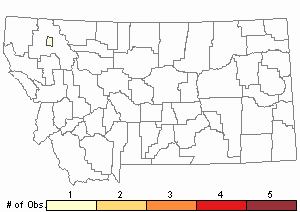View in other NatureServe Network Field Guides
NatureServe
Montana
Utah
Wyoming
Idaho
Wisconsin
British Columbia
South Carolina
Yukon
California
New York
A Dendroalsia Moss - Dendroalsia abietina
General Description
Plants: Erect stems are dendroid and sometimes frond-like, dark green, large, 1-22 cm long; the lower stem is leafy & unbranched while the upper stem is pinnately to bipinnately branched. Branches to 2 cm long, often circinate when dry, and with branched paraphyllia. Horizontal stems up to 15+ cm long and covered with clusters of brown rhizoids.
Leaves: Concave, little decurrent, and with narrowly recurved margins at the base. Costa strong, ends before the apex, and is rough on back. Erect stem leaves: 2.5-3.6 x 0.7-1.0 mm, ovate-lanceolate, long-acuminate, serrate at apex, and slightly plicate when dry. Branch leaves 1.6-2.2 x 0.5-0.6 mm, lanceolate, widest above the base, apex acuminate or somewhat obtuse and coarsely serrate at apex, and serrulate from apex to mid-leaf.
Leaf Cells: Basal cells long, often yellow. Alar cells transversely elongate. Cells with thick walls, strongly papillose on the dorsal side with one sharp papillae (projecting cell ends), and papillae extend to the leaf base or basal cells smooth.
Phenology
Capsules ripen March-June (FNA 2014).
Range Comments
Canada: BC; United States: AK, CA, ID, MT, OR, WA; Mexico (Baja California). The main range of Dendroalsia abietina runs northward from the Channel Islands and Los Angeles County to southwestern BC. Island disjuncts occur in the southern range west of Baja California and in the north near Sitka, AK (FNA 2014). In Montana, known from Flathead County (Elliott 2016).
Observations in Montana Natural Heritage Program Database
Number of Observations: 1
(Click on the following maps and charts to see full sized version)
Map Help and Descriptions
Relative Density

Recency


 (Observations spanning multiple months or years are excluded from time charts)
(Observations spanning multiple months or years are excluded from time charts)
Habitat
Habit: Usually epiphytic. Habitat: Usually found on tree trunks in areas influenced by a Pacific maritime climate. Also can be found on rock.
Reproductive Characteristics
Seta is 2 mm long. Capsule is brown, about 2.5 x 1 mm, and tapers to the mouth. Abruptly rounded to the seta. Dioicous.
Stewardship Responsibility
References
- Literature Cited AboveLegend:
 View Online Publication
View Online Publication Elliott, J.C. and A.K. Pipp. 2018. A Checklist of Montana Mosses (1880-2018). Updated 3 January, 2020. Montana Natural Heritage Program, Helena, Montana. 73 pp.
Elliott, J.C. and A.K. Pipp. 2018. A Checklist of Montana Mosses (1880-2018). Updated 3 January, 2020. Montana Natural Heritage Program, Helena, Montana. 73 pp. Flora of North America Editorial Committee, eds. 2014. Flora of North America North of Mexico. Volume 28. Bryophytes: Mosses, Part 2. Oxford University Press, Inc., NY. xxi + 702 pp.
Flora of North America Editorial Committee, eds. 2014. Flora of North America North of Mexico. Volume 28. Bryophytes: Mosses, Part 2. Oxford University Press, Inc., NY. xxi + 702 pp.
- Additional ReferencesLegend:
 View Online Publication
View Online Publication
Do you know of a citation we're missing? Elliot, J. C. 1993. Second checklist of Montana mosses. Unpublished report. U.S. Forest Service, Region 1. Missoula, MT. 45 pp.
Elliot, J. C. 1993. Second checklist of Montana mosses. Unpublished report. U.S. Forest Service, Region 1. Missoula, MT. 45 pp. Lawton, E. 1971. Keys for the Identification of the Mosses on the Pacific Northwest. Reprinted from 'Moss Flora of the Pacific Northwest'. Published as Supplement No. 2 of the Journal of the Hattori Botanical Laboratory. Nichinan, Miyazaki, Japan. 66 pp.
Lawton, E. 1971. Keys for the Identification of the Mosses on the Pacific Northwest. Reprinted from 'Moss Flora of the Pacific Northwest'. Published as Supplement No. 2 of the Journal of the Hattori Botanical Laboratory. Nichinan, Miyazaki, Japan. 66 pp. Lawton, E. 1971. Moss Flora of the Pacific Northwest. Hattori Botanical Laboratory. Japan: Yamabuki-cho, Shinjuku-ku, Tokyo. 362 pages plus appendices.
Lawton, E. 1971. Moss Flora of the Pacific Northwest. Hattori Botanical Laboratory. Japan: Yamabuki-cho, Shinjuku-ku, Tokyo. 362 pages plus appendices.
- Web Search Engines for Articles on "A Dendroalsia Moss"





